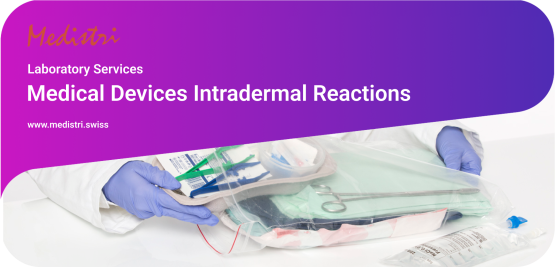(Download: Medical Devices Intradermal Reactions in PDF by Medistri)
Biocompatibility testing is a critical part of the safety evaluation process for medical devices. One of the key tests in biocompatibility testing is the irritation or intradermal reaction test. This test is designed to evaluate the potential of a medical device to cause irritation to the skin or other tissues.
In the context of irritation or intradermal reaction tests, in vitro approaches are becoming increasingly important. These tests are part of the “Big Three” in biocompatibility testing, which also includes cytotoxicity and sensitisation testing.
Testing the intradermal reactions ensures the safety of these devices by assessing their compatibility with biological systems and their potential to cause harm or adverse reactions.
👉 It is particularly important for devices that are intended to come into direct contact with the skin or mucous membranes.
At Medistri, we follow the ISO 10993-23:2021 Biological evaluation of medical devices — Part 23: Tests for irritation standard, and our tests are “In vitro”.
“In Vitro” irritation tests are a great alternative to “in vivo” tests. They are based on reconstructed human epidermis (RhE) models, which mimic the biochemical and physiological properties of the upper parts of the human skin.
This method was found to be equally sensitive in the detection of low concentrations of some strong irritant compounds when compared to the human patch testing and intracutaneous rabbit test. Therefore, a stepwise approach for irritant testing can start with the in vitro RhE model.
The developed and validated RhE models are appropriate to predict skin tissue irritation response.
Here’s a general procedure for an in vitro Skin Irritation Test (SIT):
- The test substance (minimum of 25 μL/cm² for liquid or 25 mg/cm² for solid) is applied to the RhE model.
- The model is incubated for a certain time (usually 3 hours).
- The viability of the cells is determined by means of an MTT assay. This assay measures the mitochondrial dehydrogenases’ ability to reduce the vital dye MTT.
- The test substance is considered to be an irritant to skin if the tissue viability after exposure and post-treatment incubation is less than or equal to 50%.
Medistri's in-house laboratory is a full-service contract laboratory, specialised in microbiology, analytical, bioanalytical chemistry & cell biology services, custom synthesis, and R&D.
Our laboratory works according to ISO 17025 (current version) and is accredited since 2008 by the Swiss Accreditation Service (SAS). All testing can be performed according to European or US pharmacopeias.
🎯 To learn more about Medistri’s Intradermal Reactions testing, visit on our website here or directly contact our team at contact@medistri.swiss.
- The Medistri Team
#Medistri
